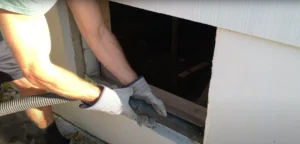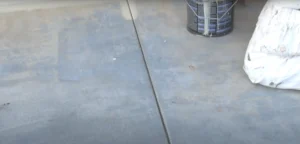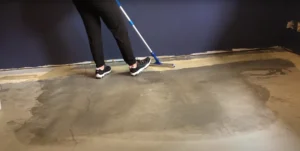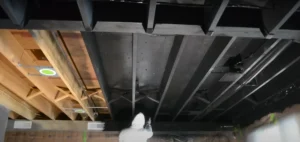Damp, dark basement walls can make your home feel gloomy. Many homeowners want to brighten up their basements but don’t know where to start. Painting basement walls is a great way to make your space more inviting.
Did you know that painting concrete walls requires special steps? Regular paint won’t stick well to concrete. This blog post will teach you how to paint basement walls like a pro. We’ll cover everything from prep work to the final coat.
Get ready to transform your basement!
Key Takeaways
- Check for water damage and mold before painting basement walls.
- Clean walls with soap and water, then apply a primer made for basements.
- Use masonry or waterproofing paint for best results on concrete walls.
- Allow each coat of paint to dry fully before adding the next one.
- Ensure good airflow during and after painting to help the paint dry faster.
Preparing Your Basement Walls for Painting
Painting your basement walls starts with proper prep work. Check for water damage and mold, then clean the walls to remove dirt and debris.
Checking for water damage and mold
Before painting your basement walls, check for water damage and mold. Look for dark spots, musty smells, or peeling paint. These signs might mean you have a bigger problem. Water damage often comes from condensation or groundwater seepage.
Fix these issues first to avoid future paint problems.
Mold thrives in damp basements and can harm your health. If you find mold, clean it with a bleach solution or hire a pro. For large water issues, call a drainage specialist. They can help fix the root cause before you start painting.
This step ensures your new paint job lasts longer and keeps your basement safe.
Cleaning the walls and removing debris
After checking for water damage and mold, it’s time to clean the walls. This step is vital for a smooth painting process. Here’s how to clean your basement walls and remove debris:
- Sweep or vacuum the area to remove loose dirt and cobwebs.
- Use a wire brush to scrub off loose mortar and paint.
- Mix warm water and mild detergent to wash the walls.
- Rinse the walls with clean water to remove soap residue.
- Dry the walls fully with towels or fans.
- Treat any efflorescence with a muriatic acid solution.
- Rinse the walls again after acid treatment.
- Allow the walls to dry completely before painting.
Step-by-Step Painting Process
Painting your basement walls can transform your space. Follow these steps to achieve a professional-looking finish.
Priming the walls
Priming basement walls is a crucial step in painting. Start by applying paint around the edges with a high-quality brush. This creates clean lines and prepares hard-to-reach spots. Next, use a roller to apply primer evenly across the wall surface.
Choose a moisture-resistant primer made for basements. This helps protect against dampness and mold.
A good primer is like a strong foundation for a house – it sets the stage for a perfect paint job.
Pick either water-based latex or oil-based primer. Work in sections to ensure full coverage. After the primer dries, lightly sand it. This creates a smooth base for your topcoat. Proper priming leads to a longer-lasting paint job in your basement.
Applying the first and final coats of paint
Time to paint! Start with a high-quality masonry or waterproofing paint. Use a nylon or polyester bristle brush for the first coat. Apply it evenly, making sure to cover every inch.
Let it dry fully before moving on. For the second coat, you can use a brush or masonry roller. Back-roll to ensure thorough coverage. If you spot any seepage after a few days, add another coat.
Always keep the area well-ventilated during and after painting.
Drying time is key for a great finish. Allow each coat to dry completely before adding the next. This might take longer in poorly ventilated areas, so be patient. If your basement lacks good airflow, stick to latex paints.
They give off fewer fumes and dry faster. Next, we’ll look at how to tackle concrete basement walls.
How to Paint a Basement Concrete Wall
Painting basement concrete walls can transform your space. Follow these steps to paint your concrete walls like a pro:
- Clean the walls: Sweep away dust and cobwebs with a broom. Scrub the walls with a wire brush and soapy water to remove dirt and grime.
- Repair cracks: Fill small cracks with a waterproofing compound. Let it dry fully before moving on.
- Apply masonry sealer: Use a roller to coat the walls with a masonry sealer. This helps the paint stick better.
- Prime the walls: Roll on a concrete primer. This step is key for a smooth finish.
- Choose the right paint: Pick a high-quality paint made for concrete surfaces. Masonry paint works well for basement walls.
- Paint the walls: Use a roller to apply the first coat of paint. Let it dry, then add a second coat for full coverage.
- Ventilate the area: Open windows and use fans to air out the space. Good airflow helps the paint dry faster.
- Wear safety gear: Put on safety glasses, a dust mask, and gloves to protect yourself while painting.
- Allow time to dry: Give the paint at least 24 hours to dry fully before using the basement.
Conclusion
Painting basement walls can be an enjoyable DIY project. With the right tools and steps, you’ll create a fresh look quickly. Prepare your walls thoroughly and use proper safety gear.
Select the appropriate paint for your basement type. Soon, you’ll have a professional-level finish that transforms your space. Your newly painted basement will be a source of pride and joy.
FAQs
1. What tools do I need to paint basement walls?
You’ll need a respirator, goggles, sandpaper, a wire brush, a paintbrush, a roller, and an angled brush. For the paint, get a waterproof primer, masonry sealant, and concrete sealing paint. Don’t forget a scraper to remove old paint.
2. How do I prep basement walls before painting?
First, check for leaks and fix them. Then, brush off loose dirt and scrape away old paint. Use sandpaper to smooth the surface. If there’s mold or mildew, clean it with a special cleaner. Make sure the walls are dry before you start painting.
3. What type of paint works best for basement walls?
Use a waterproof primer first. Then, apply a masonry sealant. For the top coat, use concrete sealing paint. This combo helps stop moisture from seeping through porous concrete blocks or cement walls.
4. How many coats of paint should I apply to the basement walls?
Apply one coat of primer, one coat of sealant, and two coats of paint. This ensures good coverage and protection. Let each coat dry fully before applying the next one.
5. Are there safety concerns when painting a basement?
Yes. Wear a respirator, goggles, and gloves. Make sure you have good ventilation. Open windows and use fans. If your basement has no windows, consider using a portable fan to move air. Take breaks often to get fresh air.
6. How long does it take to paint basement walls?
The time varies based on the size of your basement and wall condition. Prep work might take a day. Painting usually takes 2-3 days, allowing time for each coat to dry. Plan for about a week from start to finish for a typical basement painting project.





